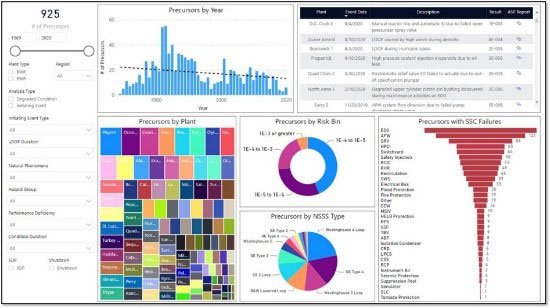Accident Sequence Precursor (ASP) Program
The ASP Program systematically evaluates U.S. nuclear power plant operating experience to identify, document, and rank operational events by calculating a conditional core damage probability (CCDP) or an increase in core damage probability (ΔCDP).
On this page:
- ASP Program Dashboard
- Program Process
- Analysis Types and Program Thresholds
- Historical ASP Annual Reports
This page includes links to files in non-HTML format. See Plugins, Viewers, and Other Tools for more information.
ASP Program Dashboard
The ASP Program Dashboard is an up-to-date, interactive database of all precursors identified since the program’s inception. The dashboard allows the user to use various filters, slicers, and visualizations using the Microsoft® Power BI® software platform to search precursors by the following (not an exhaustive list):
- Year
- CCDP/ΔCDP
- Plant Type
- Analysis Type (Initiating Event or Degraded Condition)
- Plant
- Initiating Event Type
- Hazard Group
- Duration of Degraded Conditions
- Affected SSCs
In addition to these capabilities, the user has access to all final ASP analysis reports via a results table. To access the ASP Program Dashboard, click on the picture below:
Alternative View![]()
Program Process
To identify potential precursors, the staff reviews operational events from all licensee event reports (LERs) submitted to the NRC per 10 CFR 50.73. Each LER is evaluated (on a plant unit basis) against qualitative screening criteria, for the purpose of identifying events that warrant analysis as potential precursors. For LERs that are determined to be potential precursors, the staff utilizes risk evaluations performed as part of the NRC's Significance Determination Process (SDP) for degraded conditions in accordance with Regulatory Issue Summary 2006-24, when possible. However, if potential precursors associated with LERs involve an initiating event (e.g., loss of condenser heat sink, loss of offsite power), are "windowed" with other degraded condition(s), or were not evaluated by the SDP (e.g., no performance deficiency was identified), then an independent ASP analysis is performed. Independent ASP analyses are conducted using the NRC's Standardized Plant Analysis Risk (SPAR) models and the Systems Analysis Programs for Hands on Integrated Reliability Evaluations (SAPHIRE) software. Additional information on the ASP Program may be found in the ASP Program Summary Description (Revision 2).
Analysis Types and Program Thresholds
An operational event can be one of two types: (1) a degraded plant condition characterized by the unavailability or degradation of equipment without the occurrence of an initiating event, or (2) the occurrence of an initiating event, such as a reactor trip or a loss of offsite power, with or without any subsequent equipment unavailability or degradation.
For the first type of event, the staff calculates a ΔCDP. This metric represents the increase in core damage probability for the time period during which component(s) were deemed unavailable or degraded. The ASP Program defines a degrade condition with a ΔCDP greater than or equal to 10-6 to be a precursor.
For the second type of event, the staff calculates a CCDP. This metric represents a conditional probability that a core damage state is reached given the occurrence of the observed initiating event (and any subsequent equipment failure or degradation). The ASP Program uses the plant-specific CCDP for the non-recoverable loss of feedwater and condenser heat sink, with no degradation of safety related equipment, as the initiating event precursor threshold if it is greater than 10-6. This ensures the more safety-significant events are analyzed. Since 1988, this initiating-event precursor threshold has screened out uncomplicated trips (i.e., reactor trips with no losses of safety related equipment) from being precursors because of their relatively low risk significance in most cases.
The ASP Program defines a significant precursor as an event with a CCDP or ΔCDP greater than or equal to 10-3. Significant precursors provide an input to the annual Abnormal Occurrence (Criterion II.C) and Congressional Budget Justification (Performance Goal #4) reports to Congress. The ASP Program defines an important precursor as an event with a CCDP or ΔCDP greater than or equal to 10-4.
Note that when risk evaluations performed as part of the SDP are used for ASP program purposes, the SDP color representing the significance of the inspection finding is used as the official ASP Program result. The associated risk of the four SDP colors are as follows:
- RED (High Safety Significance), which corresponds to an event with a CCDP/ΔCDP greater than or equal to 10-4
- YELLOW (Substantial Safety Significance), which corresponds to an event with a CCDP/ΔCDP greater than or equal to 10-5, but less than 10-4
- WHITE (Low to Moderate Safety Significance), which corresponds to an event with a CCDP/ΔCDP greater than or equal to 10-6, but less than 10-5
- GREEN (Very Low Safety Significance), which corresponds to an event with a CCDP/ΔCDP less than 10-6
Historical ASP Annual Reports
2020s: | |
2010s: | | 2019 | 2018 | 2017 | 2016 | 2015 | 2014 | 2013 | 2012 | 2011 | 2010 | |
2000s: | | 2009 | 2008 | 2007 | 2006 | 2005 | 2004 | 2003 | 2002 | 2001 | |
1990s: |
Page Last Reviewed/Updated Friday, July 25, 2025
Page Last Reviewed/Updated Friday, July 25, 2025

